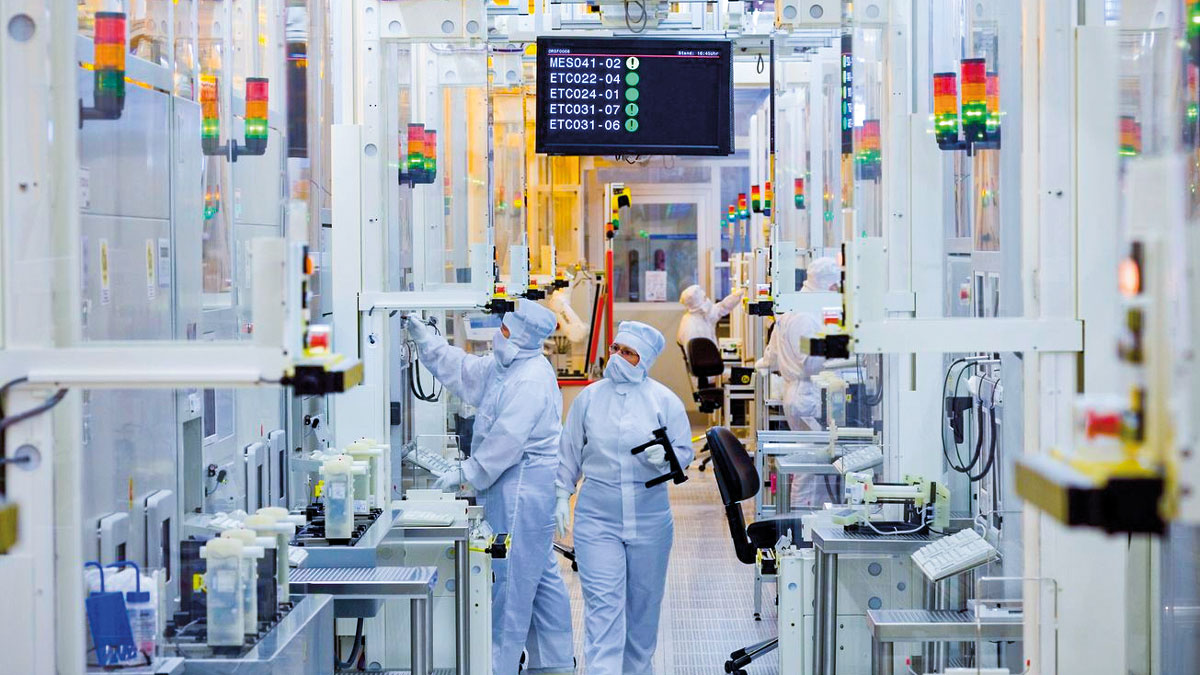European Plan Worth EUR 42bn for Semiconductors
The European Commission has proposed a plan to reduce the dependence of EU Member States on Asia or the United States in terms of semiconductors. EUR 90bn-100bn will be invested by 2030.
EU covers less than 10% of global semiconductor production
Semiconductors are everywhere: in computers, smartphones, household appliances, cars. We also meet electronic chips everywhere and they gain importance, in an increasingly digitized trade. The pandemic has shown Europe’s extreme dependence, in particular on Asia and the United States, in this field. The European Union produces less than 10% of semiconductors globally, compared to 40% thirty years ago. For semiconductors it depends 80% on Asia and 60% on Taiwan. When these countries were closed to the pandemic, Europe was faced with an unprecedented semiconductor crisis.
20% increase in European semiconductor production
Therefore, the goal is to increase European semiconductor production to 20%. To accomplish this, the European Commission puts on the table major investments: EUR 42bn initially, to reach up to EUR 90bn or 100bn by 2030. Several fields are involved, from research to the design of more innovative chips and the installation of factories in Europe.
Today, the European Union produces less than 10% of the world’s semiconductors. With globalization, it has withdrawn from this part of the economy to the benefit of the United States and Asia. But the Covid-19 pandemic has exposed the limits of this model. Europeans have obviously realized that, overnight, their suppliers could stop serving them.
Semiconductor production is a complex process: it takes years of research and development to design, produce, and trade a range of semiconductors.
Semiconductors are for electronics what oil is for industry: an essential but often invisible component, present in computers, video game consoles, smartphones, televisions, cars, airplanes, washing machines, temperature sensors for air conditioning, solar panels etc.
Creation of electronic devices of all sorts has increased dramatically since the beginning of the pandemic, between the growing telework and spending spare time at home. In corporate IT, spending on cloud infrastructure (cloud computing) has soared.
What is a semiconductor?
A semiconductor is a kind of technological wafer, a chip made of a silicon plate. It is a square of silicon a few millimetres on one side, fragile and very thin. Silicon is the most abundant element in the earth’s crust after oxygen. It comes from sand. It is also the semiconductor from which 95% of electronic components are made.
A semiconductor is a material that is neither insulating nor conductive, and its electrical properties can vary.
Electronic chips or integrated circuits are manufactured in a clean room, where they are produced on silicon boards of various sizes. Today, state-of-the-art silicon wafers are 300 mm in diameter.
It takes six to eight weeks to manufacture integrated circuits on silicon boards, which will take between 200 and 300 operations.
For their manufacture, sand must be treated, purified, and liquefied at 1700 degrees to obtain silicon ingots, which are then cut in very small silicon wafers.
With globalization and to lower costs, the players have almost all specialized in one part of their production chain: in design patents (ARM), in design and sales (Qualcomm, Nvidia, Broadcom), in manufacturing (TSMC, Global Foundries). A few rare companies still master the entire chain, such as Samsung and Intel, but also STMicroelectronics and Infineon (Europe). Not all produce the same type of components and some, like TSMC (Taiwan), are hyperspecialized in chips in high demand, making their manufacture even more strategic.
A rapidly growing market
Semiconductors are an almost continuously growing market: in 2020, it represented USD 442bn (EUR 380bn, +5.4% compared to 2019) and should continue to grow by 17.3% in 2021. Made essential to the global economy, these electronic chips have become a major strategic issue for the great powers of the planet.
The manufacture of these components is at the heart of the battle between the United States and China for domination of the high-tech sector. So much so that the current difficulties are inherited from Washington’s September 2020 decision to restrict the sale of technology to SMIC, the Chinese semiconductor giant, to counter Beijing’s ambitions.
Demand is driven by several markets: that of memories which allow information to be stored; that of smartphones and their infrastructures with the implementation of 5G; that of the automotive industry (electric cars, autonomous cars, airbag control, safety distances; engine control, battery, ‘start and stop’ system, air conditioning etc.); the entertainment industry, with the best-selling game consoles (PlayStation 5 and Xbox Series X); the Internet of Things (IoT), which allows objects to exchange information and communicate with each other; artificial intelligence and big data, with specific processors such as Xeon Ice Lake from Intel.
Geographic concentration of production, a matter of concern
A study carried out in April 2021 by the Semiconductor Industry Association and the Boston Consulting Group revealed that about 75% of the world’s semiconductor production capacity, for example, is concentrated in China and East Asia, a region significantly exposed to high seismic activity and geopolitical tensions. And that 100% of the global production capacity for the most advanced semiconductors (less than 10 nanometres) is currently located in Taiwan (92%) and South Korea (8%).
China is also concerned: without US chips, neither Alibaba nor Huawei would have become global giants. China produces 36% of the world’s electronic products, but Chinese companies provide only 7.6% of the semiconductors sold around the world. Therefore, Xi Jinping places “technological independence” at the heart of many of his speeches, as well as of the 14th Five-Year Plan (2021-2025).
Intel builds two semiconductor factories in the US
The new head of the US giant in the industry, Pat Gelsinger, has announced initial investments of USD 20bn for these new sites in Arizona. Gelsinger presented in a press release initial investments of USD 20bn (EUR 16.9bn) for these new sites in Arizona as an essential aspect of his production strategy for the United States and Europe. Intel broke its revenue record in 2020 (USD 78bn) due to 5G deployments and a tenfold increase in electronics and computer needs, related to the pandemic. But the company had a difficult time at the end of the year, when US billionaire Daniel S. Loeb, whose Third Point hedge fund holds a USD 1 billion stake in Intel, asked the company to withdraw from its production activities to focus on chip design.
Production units in Europe
Germany’s Dresden, the surrounding region of Saxony, France and Italy are highlighted as places where new Intel production capacity will be built.
For many experts, the Dresden region of Germany, where big names in the field of electronic chips, such as Bosch, Global Foundries, or Infineon, are already established, will host the Intel project. Dresden “seems to tick all the boxes,” says Jean-Christophe Eloy, president of the research firm Yole Développement, specializing in the semiconductor market. The surrounding region of Saxony has a very important potential for land and employment, especially because it is close to Poland and the Czech Republic.
European Chips Act
The European Union (EU) is working on the European Chips Act, a European semiconductor law, to defend its technological sovereignty: by 2030, the EU aims to produce 20% of semiconductors worldwide, doubling its current share.
Since the 1980s, Europe has made the choice of globalization, which has created wealth, explains Olivier Lluansi, PwC partner, but Europeans have been naive on the issues of competition, trade reciprocity, technological blockade.
Re-learning economic sovereignty
Today, the European Union is reluctant to relaunch itself in a race to make chips smaller than seven nanometres, according to a technology mastered by Samsung and TSMC – which keeps it on the market, knowing that a chip maker costs about ten billion dollars. Perhaps the EU could bet on the next step, the quantum revolution: it would have the advantage of bringing producers back to the same starting point.
However, experts say that instead of attacking the ‘Everest’, i.e., the chips, the EU should regain, step by step, its electronic sovereignty, for example, starting with printed circuits and electronic cards, much more modest than those needed for chips.
Therefore, it would re-learn, they say, how to manage the trade problems of the Member States, as well as the strategic positioning of the continent in relation to the United States or China. Europe would follow the example of the strategy already adopted for batteries, where one or two projects are underway in France and more than ten in Germany.







